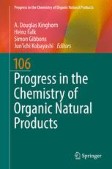Search
Search Results
-
Dietary Diterpenoids
A number of foods, vegetables, fruits, and beverages (tea, coffee, and liqueur) contain many kinds of diterpenoids (mainly abietanes, cembranes,...
-
Dietary Diterpenoids
A number of foods, vegetables, fruits, and beverages (tea, coffee, and liqueur) contain many kinds of diterpenoids (mainly abietanes, cembranes,...
-
Design of a redox-proficient Escherichia coli for screening terpenoids and modifying cytochrome P450s
High-value terpenoids are found in plants, animals and microbes, with applications spanning health to agriculture. However, moving their biosynthetic...

-
Structure-guided product determination of the bacterial type II diterpene synthase Tpn2
A grand challenge in terpene synthase (TS) enzymology is the ability to predict function from protein sequence. Given the limited number of...

-
Bioactive Compounds and Biological Activities of Hedychium Species
The genus Hedychium J. Koenig (Family: Zingiberaceae) is an important source of traditional folk medicine in India, helpful considering traditional...
-
Bioactive Compounds and Biological Activities of Hedychium Species
The genus Hedychium J. Koenig (Family: Zingiberaceae) is an important source of traditional folk medicine in India, helpful considering traditional...
-
Archaeology of Biomaterials: Mummies, Ivories, Resins and Textiles
This chapter reviews some of the major advances made using Raman spectroscopy as an analytical technique for the characterisation of biomaterials in...
-
Factors that influence the extraction methods of terpenes from natural sources
Due to their various applications, terpenes and terpenoids are secondary metabolites of industrial interest. These compounds can be found in a wide...

-
Analysis of diterpenic compounds by GC-MS/MS: contribution to the identification of main conifer resins
The three principal types of molecules composing diterpenic resins are the abietanes, pimaranes and labdanes. The study of their fragmentation was...

-
Production of the forskolin precursor 11β-hydroxy-manoyl oxide in yeast using surrogate enzymatic activities
BackgroundSeveral plant diterpenes have important biological properties. Among them, forskolin is a complex labdane-type diterpene whose biological...

-
Intra-Specific Chemotypic Variability of Forskolin Content in Coleus forskohlii (Wild.) Briq. Growing in Nilgiri Hills of India
Plant metabolite varies with season and geographic conditions. The present study is aimed at the identification of the potential chemotypes of Coleus...
-
The Laurencia Paradox: An Endless Source of Chemodiversity
Nature, the most prolific source of biological and chemical diversity, has provided mankind with treatments for health problems since ancient times...
-
Secondary Metabolites from Higher Fungi
Secondary metabolites of higher fungi (mushrooms) are an underexplored resource compared to plant-derived secondary metabolites. An increasing...
-
Vibrational Circular Dichroism Absolute Configuration Determination of Natural Products
The most widely used physical methods for the chemical analysis of natural products are currently well established, although in the case of...
-
Chemosystematics of Marchantiophyta
On the basis of morphological characteristics, liverworts have been divided into the Marchantioid group or “complex thalloids”, and the...
-
Chemical Relationships Between Algae, Bryophytes, and Pteridophytes
The evolutionary origin of land plants (embryophytes) from their green algal ancestors was a pivotal event in the history of life (388, 533)....
-
Chemical Constituents of Marchantiophyta
Jungermannia hattoriana produces β-cyclocitral (12) (see Table 4.1). This represented the first isolation of this compound...
-
Natural resins and balsams from an eighteenth-century pharmaceutical collection analysed by gas chromatography/mass spectrometry
Historical nomenclature has not always been unequivocally associated with the botanical origin of natural resins. The availability of natural resins...

-
Jatropha Diterpenes: a Review
Terpenes are the largest group of phytochemicals that exhibit diverse functions in mediating antagonistic and beneficial interactions in, and among,...

-
Ent-kaurane diterpenoids and glycosides: Isolation, properties, and chemical transformations
This review is devoted to ent -kaurane diterpenoids and related glycosides, which represent two naturally occurring groups of compounds with...
